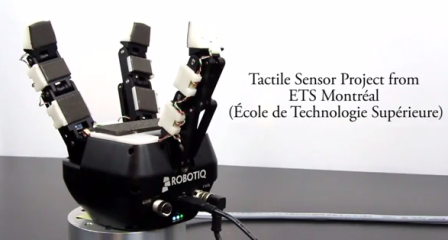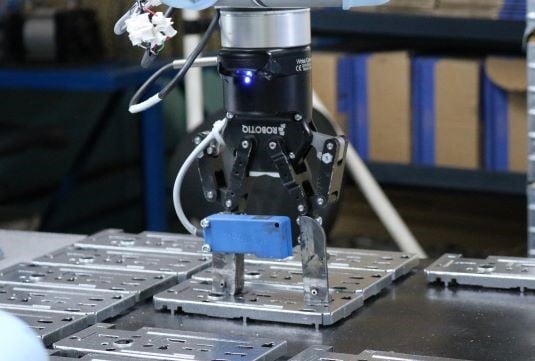Integrated Tactile Sensors for Robotic Gripper from ETS
Posted on Feb 12, 2014 in Robot Grippers
4 min read time
 Several members from the École de technologie supérieure (or ETS) in Montreal have been working on tactile sensors which they have added to the 3-Finger Adaptive Robot Gripper. In order to understand this adaptation which can be used in combination with the Robotiq Gripper we asked Jean-Philippe Roberge, who was involved in this project to explain more about this interesting development.
Several members from the École de technologie supérieure (or ETS) in Montreal have been working on tactile sensors which they have added to the 3-Finger Adaptive Robot Gripper. In order to understand this adaptation which can be used in combination with the Robotiq Gripper we asked Jean-Philippe Roberge, who was involved in this project to explain more about this interesting development.
1. Can you briefly describe the technology used in the design of your tactile sensors?
Basically, you can consider that the sensor is made up of three distinct parts: the skin, the fabric and the printed circuit board (PCB).
-
The skin is the portion of the tactile sensor that normally interacts with the outside world. It is composed of a special Silicon which is mixed up homogeneously with Nickel fiber and Nickel nitride. We also mixed in two kinds of nano particles (BaTiO3 and PMNPT) in order to improve the stiffness of the skin and the global accuracy of the sensor.
-
The fabric is located just underneath the skin. It is a common conductive fabric that is widely available on the market.
-
Finally, the printed circuit board (PCB) is custom-designed and is composed of a PSoC microcontroller mounted with other electrical components. The microcontroller is the processing unit, it is responsible for acquiring the tactile measurements, treating the information and managing the communications.
2. If we compare your tactile sensors with what the Stanford Biomimetics and Dexterous Manipulation Lab (BDML) or Takktile have done, what differences are there? What are the advantages of your tactile approach?
The main difference would be in the design of the sensor itself and more particularly in the way we use nano particles to improve both the accuracy and resolution of the measurements for the electrical capacity. We have developed an innovative micro-structure based dielectric material to enhance the capacitive sensing, for which we also have a US patent. This allows us to sense a much lower minimal force (here, we are talking of about 10^-4 Newtons) than what could be measured with the sensors from Stanford or Takktile. Likewise, it is important to mention that we have a different approach to measuring the dynamic signal and that our integration is significantly different.
Learn more about the Stanford BDML sensing application here,and for a more generalized blog post from Robotiq about tactile sensors here, while more information is available on the Takktile sensor here.
3. What might be some of the reasons for measuring in a dynamic way vs a static way?
To understand static and dynamic data, we must first recognize that these modes are used in different contexts. Using static data is relevant in cases where someone is interested in measuring the pressure applied by the robotic end effector while, at the same time, knowing the distribution of that pressure on the skin's surface. By knowing this information, not only is it possible for a user to know the pressure the gripper is applying on an object, but also the way it is holding the object. On the other hand, the main benefit of acquiring the dynamic signal is that it allows you to get relevant information about surface textures. In fact, by measuring vibrations while rubbing the sensor on a surface, you can collect additional information on the characteristics of that surface. Those characteristics could then be used for surface recognition and/or for partial surface characterization. This is a very popular research field at the moment. Measuring vibrations also opens the door for other interesting applications such as slippage detection.
4. What kind of robotic applications would be interesting to develop with a 3-Finger Adaptive Robot Gripper and your tactile sensor?
From an industrial robotics point of view, our tactile sensor could be used together with the 3-Finger Adaptive Robot Gripper for a lot of applications. For example, they could be used, to verify the quality of a grasp when industrial robots take objects that are not in an already known configuration. It could also be used to determine an object's configuration by relying only on touch instead of artificial vision or other more complex means. Finally, it could also serve in contexts where a user wants to automatically get a rough idea of how smooth a surface is. This could be achieved just by slightly rubbing the sensor on that surface.
From a research point of view, a lot of interesting applications involve the study of dynamic data's fast fourier transform (FFT). The FFT allows you to identify textures among other things and could also help to define criteria for slippage detection. This could provide great feedback for some particular contexts of robotic material handling.
5. What are the next steps in the development of this sensor?
For the foreseeable future, we will continue improving our communication protocols to speed up communications with the sensors. We will also work to design a new PCB that would allow us to eliminate the USB/RS485 converter that is currently being used. It is also very likely that we will be able to improve our sensor by adding new features, such as shear detection.
Robotiq is always interested in learning what great ideas you have for our Adaptive Robot Grippers. We look forward to following up on your new developments.








Leave a comment